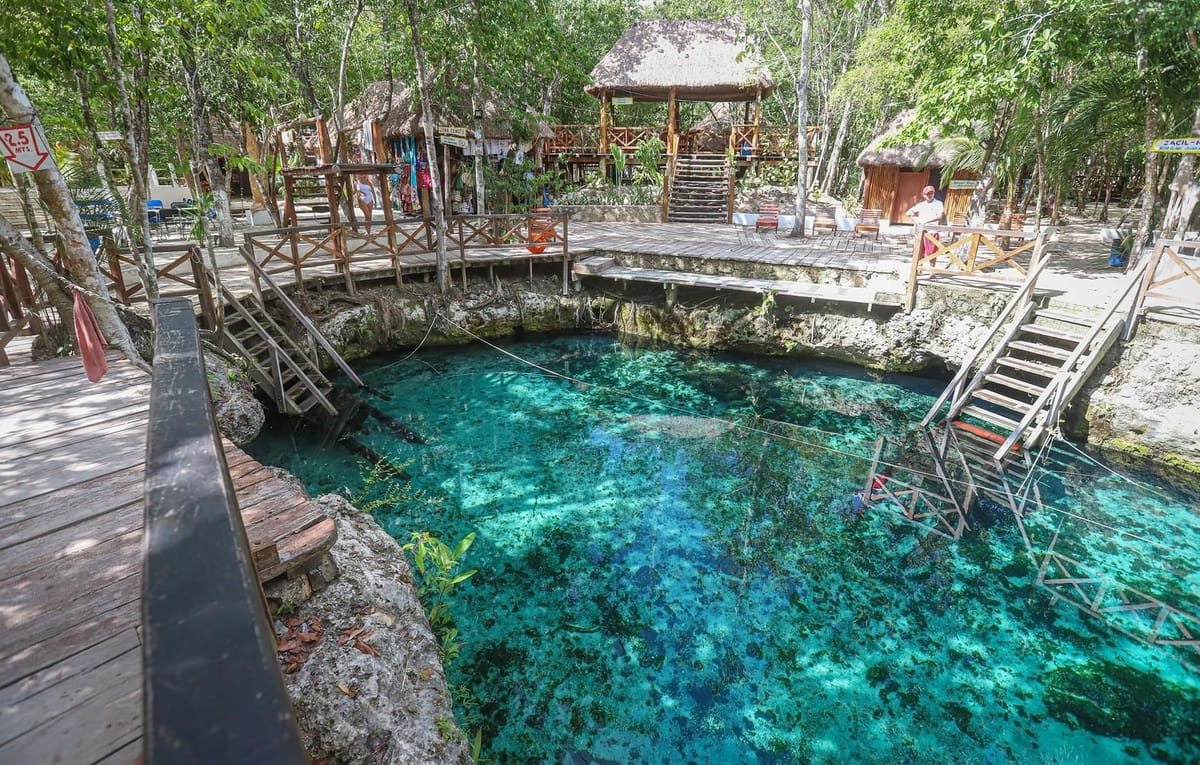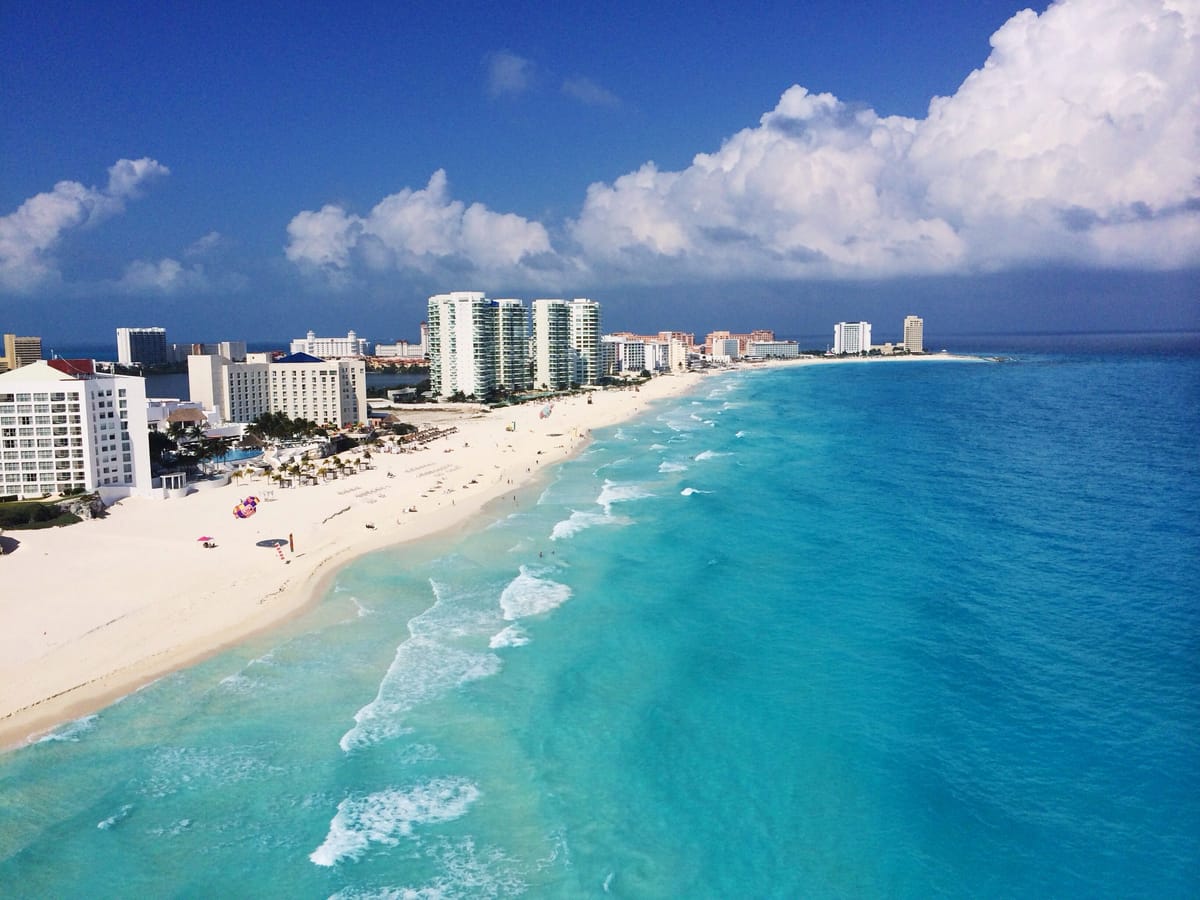Visiting Tulum in August: Weather, Pros & Cons, and Tips
Everything there is to know about visiting Tulum in August

Visiting Tulum in August can be a tropical adventure—if you're prepared for the heat and occasional rain. August falls in Tulum’s low season, meaning fewer crowds and lower prices, but it's also one of the hottest and wettest months of the year.
In this August in Tulum guide, we’ll cover everything you need to know—from weather (Is Tulum too hot in August? Does it rain a lot?) to the best things to do, how August compares to other months, and how to handle hurricane season.
Let’s dive into a no-nonsense rundown of what you can expect when visiting Tulum in August, and decide if it's right for you.
Tulum Weather in August
August in Tulum is hot, humid, and a bit unpredictable. It’s the peak of summer, so expect sultry days and warm nights. Here are the key weather highlights for Tulum in August:
- Temperatures: Daytime highs often reach the low to mid-90s °F (32–34°C). Average daily temps hover around 83°F (28°C), with steamy afternoons and slightly cooler mornings/evenings. Nighttime lows still stay around 75°F (24°C), so it never truly gets “chilly.”
- Humidity: It’s very humid in August – around 80% on average. That means the heat can feel even more intense (think “tropical sauna” vibes). Pack breathable clothing and hydrate often.
- Sunshine: Despite the rains, August still sees plenty of sun – about 12-13 hours of daylight and ~10 hours of sunshine per day. Remember the UV index is extreme (often 11+ at midday) – slather on that SPF and wear a hat!
- Sea Temperature: The Caribbean Sea is like bathwater in August, with sea temps in the mid-80s °F (around 29°C), perfect for swimming.
Is Tulum too hot in August?
It’s definitely hot – August is Tulum’s hottest month of the year. With afternoons in the 90s °F and high humidity, the heat can feel intense. Midday outdoor activities will leave you drenched in sweat. However, whether it’s “too hot” really depends on your comfort level:
- If you’re coming from a cooler climate, Tulum’s August heat may feel overwhelming. You’ll want a pool or ocean nearby at all times to cool off and air conditioning (or at least a strong fan) in your accommodations at night.
- Travelers from already-hot places sometimes find it manageable. As one visitor from Texas noted, “we always go to Tulum in August. It is HOT, but... less severe hot-wise than Dallas. In other words, if you’re used to Southern U.S. summers or similar, Tulum’s heat might be on par or even a bit easier with the ocean breeze.
- Timing is everything: Plan to do your sightseeing or activities in the early morning or late afternoon/evening when temperatures are a tad lower. For example, visit the Mayan ruins right when they open, or stroll the beach at sunset instead of mid-afternoon.
- Take frequent breaks in the shade or indoors during the peak heat of 12–3 pm. This is a great time for a long lunch, a nap, or a dip in a cenote (cool sinkhole pools) to refresh.
- Stay hydrated and prepared: Always have water with you, and use electrolyte packets or coconut water to replenish what you sweat out. Wear light, breathable fabrics (linen, cotton) and a hat. You can even carry a small portable fan or mist spray – it sounds extra, but you’ll thank yourself when you’re melting under the Yucatán sun.
In summary, yes, it’s extremely hot in August, but with some planning and coping strategies, you can still enjoy Tulum. Many travelers do visit in August despite the heat—just don’t underestimate the sun and humidity. If you absolutely hate heat, you might find it uncomfortable; but if you love warm weather or don’t mind moving at a slower pace, August in Tulum is doable.
Does it rain a lot in Tulum in August?
August falls in Tulum’s rainy season, but “does it rain a lot?” has a nuanced answer. You should expect some rain, but it’s typically not an all-day washout situation. Here’s the breakdown:
- How much rain: On average, Tulum gets around 120–130 mm of rain in August, which is roughly 4.8–5 inches. In practical terms, that’s significant, but it usually comes in spurts.
- Rainy days: It might rain on about half the days of the month (around 15–21 days have some rain. That sounds like a lot of days, but often it’s just a quick shower in the afternoon or overnight thunderstorm.
- Rain pattern: A typical August day might be sunny or partly cloudy in the morning, then a brief downpour in late afternoon to cool things off, and then clear up again. Those tropical showers can be intense but short-lived. It’s not like it drizzles non-stop. In fact, locals will tell you even in rainy season it’s rare to get an entire day of rain without any sun.
- Be prepared: Carry a compact umbrella or a light rain jacket in your day bag so a surprise shower doesn’t catch you off guard. If it does start pouring, just duck into a bar or café for a bit – chances are it will pass within an hour. After the rain, the sun often pops back out and the jungle smells amazing.
- Forecasts look worse than reality: Don’t be alarmed if your weather app shows thunderstorm icons every day of your trip. That usually just means a high chance of a brief storm at some point. It might rain hard for 30 minutes where you are and then be gorgeous the rest of the day.
- Flooding: One thing to note – Tulum’s roads can flood quickly during heavy rain (the drainage isn’t great). This is more of an issue if you’re driving; just use caution if you hit deep puddles. On the upside, the rain brings slightly cooler temps and can be refreshing after the intense heat.
Overall, yes it rains quite a bit in August, but not enough to ruin your trip if you plan around it. Many travelers actually enjoy the dramatic thunderstorms and the fact that the rain keeps the jungle green and lush. Just don’t forget that umbrella and maybe pack a pair of sandals/flip-flops for wading through puddles in town!
Tip: August is also part of the hurricane season in the Caribbean (more on that later). While full-blown hurricanes are rare, there’s a higher chance of tropical storms or depressions in late summer. Keep an eye on the forecast as your trip approaches, but don’t stress too much – big storms are usually well-predicted in advance.
Pros and Cons of Visiting Tulum in August
Pros:
- Fewer crowds and laid-back atmosphere
- Lower hotel and travel prices
- Warm sea perfect for swimming/snorkeling
- Wildlife encounters (turtles, whale sharks)
- More local experiences, fewer tourists
Cons:
- Intense heat and high humidity
- Frequent rain showers
- Risk of hurricanes or tropical storms
- Sargassum seaweed on beaches
- Increased mosquitoes and bugs
- Reduced nightlife and party scene
Like any time of year, August in Tulum comes with upsides and downsides. Here’s a quick overview of the pros and cons to help you weigh your decision:
Why August in Tulum can be good:
- Fewer Crowds & Laid-Back Vibes: August is low season, so you won’t be jostling for space at the beach or need dinner reservations weeks in advance. Popular spots that are packed in winter feel much more relaxed. You can visit the Tulum Ruins without massive tour groups or find a front-row beach lounge without waking up at dawn. It’s a great time to experience Tulum’s natural beauty in a more tranquil setting.
- Lower Prices & Great Deals: One of the biggest perks of August is budget-friendly travel. Hotels and rentals often slash prices in summer – in fact, August is typically the cheapest month for Tulum hotels (rates can be ~30–40% lower than high season). You can score luxury accommodations or beach cabanas that might be out of reach in winter. Your travel dollars will definitely stretch further in August.
- Warm Water & Outdoor Fun: The Caribbean Sea is at its warmest, so swimming, snorkeling, and diving are delightful. No bracing yourself for a cold plunge – it’s like bathwater. This warm water also attracts amazing marine life in summer. August is prime time for wildlife: you can snorkel with sea turtles (it’s nesting/hatching season on nearby beaches) and even join tours to swim with whale sharks (gentle giants that migrate through Yucatan waters mid-summer. Plus, the jungle is green and alive from the rains – you’ll see lush vegetation and active wildlife.
- Unique Events & Local Life: While peak tourist events aren’t happening, you can catch more local flavor. For example, nearby in Playa del Carmen, the ZoukMX Festival usually takes place in late August – a 10-day dance and music event an hour away. Also, with fewer tourists, you might get more interaction with locals and expats. It feels a bit more authentic and slow-paced. Some bars or hostels host summer parties, and it’s easier to meet people when the town isn’t dominated by huge crowds.
- Flexible Plans: Because it’s not crazy busy, you can be more spontaneous. Wake up and decide you want to go on a cenote hopping tour? You’ll likely find a spot the day before or even same day. In high season, many tours or the best restaurants would be fully booked. August gives you the freedom to play things by ear, which is perfect for a relaxed vacation vibe.
Challenges of visiting Tulum in August:
- Intense Heat & Humidity: No way around it – it’s really hot. The combo of high temperature and humidity can be draining if you’re not used to tropical weather. You may need to slow your pace (think siesta time in the afternoon). Also, not everywhere in Tulum has A/C. Many eco-hotels or beach cabanas might rely on fans. Double-check that your lodging has air conditioning or at least good ventilation, especially if you need a comfortable sleep.
- Rain & Storms: As discussed, expect rain showers regularly. While they’re usually short, they can still disrupt your beach day or cause you to postpone an activity. There’s also a small risk of encountering a tropical storm or hurricane in late August. This is the height of hurricane season (Aug–Oct are the peak months for potential hurricanes in the Riviera Maya). The chance of a direct hit is low, but it’s not zero – in 2021, for instance, Hurricane Grace (Category 1) made landfall near Tulum in mid-August.
- Sargassum Seaweed on Beaches: Summer months often bring sargassum, a brown seaweed that washes up on Caribbean beaches. Generally the worst months for seaweed are July and Augustat, so by visiting in August you may see (and smell) some seaweed on Tulum’s normally postcard-perfect beaches. Some days the beach could be covered in it, other days mostly clear – it varies with the currents. Resorts and city crews do try to clean it up daily, but if a lot comes in, the water can be a bit icky for swimming until it’s cleared. This isn’t unique to Tulum – it affects the whole Riviera Maya coast in summer. If you encounter heavy seaweed, consider a day trip to Cozumel or Isla Mujeres (islands that often have cleaner beaches in summer) as an alternative. This Facebook page updates and notifies visitors of the seaweed conditions daily.
- Mosquitoes & Bugs: Rain + jungle = mosquitos. August is mosquito season, and those little biting bugs can be fierce, especially around sunset or in the mangroves. Bring good insect repellent (ideally with DEET or picaridin) and maybe light long sleeves/pants for evenings. If your hotel has a bed net, use it. Sand flies (“no-see-ums”) can also be an issue on the beach at dawn/dusk. Basically, expect some itchy bites and come prepared to combat them.
- Some Businesses on Break: While Tulum is not completely shut down (you’ll still find plenty of restaurants, bars, and tours operating), a few businesses take advantage of the slow period to do renovations or give staff a vacation. You might find your favorite restaurant is closed for a couple weeks in August, or a boutique has limited hours. It’s nothing major, but don’t be shocked if a place you wanted to try isn’t open. There’s usually a workaround or plenty of other options available.
- Shorter Party Scene: If you’re going for the party, know that Tulum’s legendary nightlife is a bit sleepier in the off-season. The big DJs and events mostly happen in high season (New Year’s, etc.). In August, weekends will still have clubs and beach parties going, but on weeknights some venues could be pretty quiet. On the plus side, no cover charges and easier bar service!
In summary, the trade-offs in August are clear: you get Tulum more to yourself and at a discount, but you contend with heat, rain, and some seasonal nuisances. For many, the pros (saving money, no crowds, warm water) outweigh the cons – but it depends on your travel style and tolerance. Now, let’s see how August compares to other times of year.
August vs. Other Months in Tulum (Peak Season or Shoulder Season?)
How does Tulum in August stack up against visiting in other months? Here’s a quick comparison to give context:
August vs. Winter (Peak Season): Tulum’s peak tourist season is roughly December through April. During those months, the weather is dry, sunny and cooler – average highs in the low 80s °F instead of 90s, and much less humidity. Virtually no sargassum seaweed, and almost no rain. Sounds perfect, right? The catch: it’s expensive and crowded. Hotels and flights in peak season can cost 2-3 times what you’d pay in August, and the beaches, ruins, and restaurants are packed with tourists escaping winter up north. If you prioritize ideal weather and lots of nightlife/events, winter is great – but you’ll sacrifice solitude and budget.
August, on the other hand, gives you far fewer people and much lower costs, at the expense of weather comfort. It’s a classic trade-off: pay more for perfect weather, or deal with some heat/rain for a cheaper, quieter trip.
August vs. Spring Shoulder (May and November): May and November are often called shoulder seasons in Tulum – just before/after the big rush. These months have a mix of advantages: the weather is relatively good (warm but not as humid as summer, and rain is lighter than in August), and prices/crowds are moderate.
For example, November is after hurricane season and tends to have lovely conditions as things cool down. May is just when humidity starts rising, but still not as extreme as June–August. Compared to August, both May and November will generally be more comfortable climate-wise and still somewhat affordable. However, you might not get quite as rock-bottom prices as late summer, and there will be more tourists around than in August (especially in late November when high season is ramping up).
Essentially, shoulders are a compromise – many people find them the best times to visit Tulum. But if your schedule only permits August, it’s not a bad choice as long as you know what to expect.
August vs. Early Summer (June/July): June and July are also off-peak in Tulum, with very similar conditions to August. June is the start of the true rainy season, and July is hot and wet too. One difference: July can be a bit busier than August, since a lot of families and college students on summer break travel then.
By August, some of that summer vacation rush eases off (especially late August when schools resume). Weather-wise, June/July might have slightly less hurricane risk than late August, but all three months are comparable (hot, humid, some storms).
If choosing among them, note that July and August are the peak of the seaweed issue, whereas June sometimes has a bit less sargassum early on. But differences are minor. All said, if you find a great deal in July and that works better, you’ll have a very similar experience to August.
August vs. September/October: These two months are the low-low season. If you think Tulum is empty in August, it’s even quieter in September (the least crowded month of all). Prices drop further and you might feel like you have the place to yourself.
However, September and early October have the most challenging weather – they’re the rainiest and the peak of hurricane probability. Many businesses do take their breaks in September. So, while you can get ultra-cheap deals, you’re almost gambling with weather.
By mid-to-late October, things start to improve (rain eases up). Compared to August, September will be a bit cooler (temps just slightly lower) but much rainier; October starts getting nicer but you might still catch some storms.
If you want to push the low season benefits to the max and don’t mind risk, September might work – but for most people, August is a safer middle ground than September.
Bottom line:
August is squarely off-season in Tulum, with all the pros and cons that implies. It’s hotter and wetter than any winter month, but also far cheaper and more peaceful.
Against the adjacent months, August sits in a middle spot – not as totally empty (or rainy) as September, but deeper into the low season than July. If you’ve only ever been to Tulum in peak season, August will feel very different (slower, sweatier, but maybe more authentic).
And if you’re debating August vs. winter, it really comes down to budget+crowds vs. weather. Many travelers actually enjoy Tulum most in shoulder season (Nov or May), but August can still be a great time if you’re prepared.
Now that you know the general trade-offs, let’s talk about what you can actually do in Tulum in August and how to make the most of your trip!
Best Things to Do in Tulum in August
Just because it’s hot and a bit wet doesn’t mean you can’t have an amazing time! In fact, some activities are even better in the summer. Here are some of the best things to do in Tulum in August and tips to enjoy them:
- Enjoy the Beaches: Yes, it’s steamy out, but that turquoise Caribbean water is calling! Early morning or late afternoon/evening are the best times for the beach in August. At sunrise, the beaches are nearly empty and the air is a tad cooler – a morning dip can be magical. By 11 am, the sun is intense, so you might retreat to a beach club with umbrellas or find a hammock under a palm. Playa Paraíso and Playa Ruinas (by the Tulum Ruins) are gorgeous spots to chill. In the late afternoon (3–5 pm), head back out as the sun’s angle softens.
Sunset swims in Tulum are lovely (sunsets are on the west side, but the sky still lights up beautifully over the ocean).
Keep in mind the potential seaweed – if you find one beach too seaweedy, you can try another or ask locals which spots are clearer that day. If it’s a rainy day, consider skipping the beach and hitting a cenote or spa instead. - Explore Mayan Ruins and Culture: Tulum’s famous clifftop Mayan Ruins are a must-see, and August is a decent time to visit them if you plan right. Go right when they open (usually 8 am) to beat the heat and any crowds. It will still be warm, but not as brutal as midday.
The Tulum Ruins have almost no shade, so bring water, a hat, and sunscreen. The views of the Caribbean from the ruins are worth the sweat! Another option is visiting Coba, a larger Mayan site about 45 minutes inland. Coba is mostly under jungle canopy (more shade) and you can still climb the big pyramid there (as of last known, check if open).
The jungle will be humid, but at least you’re not under direct sun. Plus, fewer people go in off-season, so you might have a quiet exploration. Some tour companies offer combo trips that include Coba and a cenote swim after – a great August combo.
Also, check if any local cultural events are happening: sometimes there are small community festivals or events for visitors even in low season (ask around in town). - Snorkel with Sea Turtles at Akumal: Akumal Bay, about 30 minutes north of Tulum, is famous for its resident sea turtles. Summer (June–August) is actually prime nesting season for turtles on the beaches around Tulum and Akumal, which means a good number of turtles hang out feeding in the bays.
You can take a short trip up to Akumal in the morning and snorkel right from the beach to see green sea turtles munching on seagrass. It’s incredible to see these gentle creatures up close in the wild. It’s important to go with a guide now (they have regulations to protect the turtles), but it’s very much worth it. Early morning is best before it gets too hot and to avoid potential afternoon storms. Bring your own snorkel gear if you have it, or rent on site. - Swim with Whale Sharks: If you’re up for a once-in-a-lifetime animal encounter, August is peak whale shark season in the Yucatán peninsula. Whale sharks (the world’s largest fish) congregate in the warm waters off Isla Mujeres and Holbox (north of Cancun) each summer.
From Tulum, you can book a day tour that takes you to Cancun to hop on a boat and head out to the open ocean to snorkel with these gentle giants. It’s a long day (expect a very early departure), but the experience of swimming alongside a 20-30 foot spotted whale shark is unforgettable.
They typically run these tours through mid-September, so August is prime time. Just choose a reputable operator that follows wildlife guidelines. If you love marine life, this is a huge draw for visiting in August because you can’t do it in winter.
Note: if you’re prone to seasickness, take precautions, as the boat ride can get bumpy. - Hit the Adventure Parks or Lagoons: On a cloudy or cooler day (or if you’re just done with the beach), consider checking out nearby adventure parks (like Xel-Há, an open-air aquarium park, or Xplor which has ziplines and underground rivers.
These eco-parks are less crowded in summer and can be a blast with fewer people around.
Visit Kaan Luum Lagoon, which is a stunning blue lagoon just south of Tulum that’s mostly shallow with a deep cenote in the middle – it’s like a giant natural swimming pool and usually pretty empty on weekdays. Kayaking or paddleboarding in the lagoon.
The Si’an Ka’an biosphere reserve (biosphere south of Tulum) is also an option, though August heat might make it a very sweaty activity unless done at dawn or dusk. - Wellness, Yoga & Spa Time: Tulum is known for its wellness scene – yoga studios, sound healing, temazcal ceremonies (Mayan sweat lodge), and spa retreats. August might actually be a perfect time to indulge in these, especially on days when midday outdoor activity is a no-go.
Many hotels have on-site yoga in the mornings, or you can drop into classes in town or at Yoga Shala, Sanara, etc. A temazcal ceremony in August will be hot (it’s basically a sweat ritual in a small hut with steam), but hey – you’re sweating outside anyway, might as well make it spiritual! Just be sure you’re well-hydrated and perhaps avoid doing it on the hottest day. Massages and spa treatments might also be discounted in low season, so pamper yourself. It’s a nice way to recharge and escape an afternoon thunderstorm. - Dining and Nightlife: August is a good time to explore Tulum’s food scene without fighting for reservations. You can likely walk into popular restaurants like Hartwood, Arca, or local taco joints without much wait.
Enjoy leisurely dinners – maybe even sit outside since warm nights are lovely (bring mosquito repellent though for outdoor seating). As for nightlife, as noted, it’s quieter but there’s still fun to be had. On weekends, beach clubs like Papaya Playa Project or Casa Jaguar might host parties.
Downtown Tulum (aka Tulum Pueblo) has bars that will be lively with a mix of locals and travelers. And since there are fewer visitors, you might end up making friends and creating your own little gathering.
Keep an eye on flyers or ask hostel folks what’s happening that week – events aren’t as regular as in high season, but something usually pops up. - Cool Off in the Cenotes: Cenotes are crystal-clear freshwater sinkholes scattered around the Tulum area – basically nature’s perfect swimming pools. In August’s heat, visiting cenotes is a must. Spots like Gran Cenote, Dos Ojos, Cenote Calavera, or Cenote Azul let you swim in refreshing cool water surrounded by cave walls and jungle. It’s bliss on a hot afternoon.
Go early in the day for fewer people, or even in the rain – you’re gonna get wet anyway! Snorkeling in cenotes is fun (you might see fish or turtles), and some cenotes have cave diving for the certified.
Pro tip: the water in cenotes can feel chilly compared to the ocean, which in August is actually a welcome relief. Bring water shoes (rocks can be sharp) and cash for entry fees.
In short, Tulum in August still offers all the classic activities – beach, ruins, cenotes, wildlife – just with a bit more strategy (timing and weather-watching). The heat might slow you down, but that can lead to a more chilled-out trip: long swims, hammock time with a book under the palms, and spontaneous adventures when the conditions are right.
Hurricane Season Risks and Precautions
Traveling to Tulum in August means you’re stepping into hurricane season. Don’t let that scare you away, but you should be informed and prepared. Here’s what you need to know about hurricanes and tropical storms when visiting in August:
- Hurricane Season Basics: The Atlantic/Caribbean hurricane season runs June 1 through November 30, with the highest risk between August and October. This is when conditions are most favorable for storms to develop. In Tulum’s region (the Riviera Maya), statistically September is the peak for hurricanes or tropical storms, but late August is also a time to stay alert. Many years, August passes with just some rain and maybe a named tropical storm that doesn’t amount to much locally. But occasionally, a hurricane can hit. For example, in August 2021 Hurricane Grace made landfall near Tulum as a Category 1 stormapnews.com, causing a couple days of intense wind/rain and some power outages. It was an isolated case, but shows it’s possible.
- Monitoring the Weather: If you plan an August trip, start casually checking tropical weather outlooks a week or two before. The National Hurricane Center (NHC) gives forecasts on any tropical depressions or storms brewing. The good news is, hurricanes don’t sneak up last-minute – you’ll usually have several days’ warning if something is heading toward the Yucatán. There are apps and websites (like Windy, or the NHC site) that can keep you updated. Once in Tulum, ask your hotel staff if there are any storm updates – they will definitely know if something is coming. But don’t obsess: remember that the chance of any one week in August having a hurricane is relatively low.
- What if a Storm Is Forecast? Depending on the timing, you have a few options. If a hurricane is predicted to hit while you’re there, authorities might issue evacuations or advise tourists to relocate. Often, if a significant hurricane is coming, airlines will allow you to change flights without fees, and hotels might refund or let you reschedule (again, check their hurricane policy). This is where having travel insurance and/or flexible bookings pays off.
If it’s a smaller tropical storm, you might just need to hunker down in your hotel for a day or two. Most hotels in Tulum are experienced with storm prep – they have generators, they’ll board up windows if needed, and they’ll tell guests exactly what to do. Listen to any instructions given. It could be as simple as “stay in your room tomorrow and don’t go outside until we give all-clear”. It might sound scary, but structures are built to withstand a lot, and locals ride out these storms regularly. - Safety Precautions: In the unlikely event you’re in Tulum during a hurricane or big storm, safety comes first. Stay away from the beach (storm surge waves are no joke). Have a little emergency kit: flashlight, extra battery pack charged up, enough water and snacks for a day indoors. Keep your passport and important documents in a waterproof bag. Usually, power and Wi-Fi might go out during the height of a storm, but cell service often still works intermittently – let family know you might be offline for a bit. After the storm, be cautious about floodwaters or debris if you go outside. Again, hotels and local authorities will guide you.
- Travel Insurance & Flexible Plans: We mentioned it before but it bears repeating – get travel insurance that covers weather. Not all basic policies automatically cover hurricane-related cancellation (some require you to buy that coverage specifically), so read the fine print. You want coverage for trip interruption and evacuation at least. Some people also opt for “Cancel For Any Reason” coverage if traveling in peak hurricane time, which allows you to cancel preemptively if you just get too nervous (though that’s pricier). Also, try to book hotels/Airbnb's with flexible cancellation when possible for August – just in case a hurricane pops up a week before, you can adjust dates. Many places in the Riviera Maya have adopted hurricane refund policies because they know it’s a concern for travelers.
- Don’t Panic: It’s worth noting that Cancun/Tulum has a pretty robust infrastructure for tourism, and even in past hurricanes (like the big ones: Gilbert in ‘88, Wilma in 2005, etc.), the area rebounded quickly. Locals are well-practiced in storm prep. If a hurricane isn’t directly coming to Tulum, you might just get some heavy rain and wind on the outskirts – which can actually be a fascinating experience if you’re safely indoors. Some travelers have stories of bonding with other hotel guests over board games and margaritas while a storm raged outside. It’s travel – unexpected things can happen anytime, anywhere (ask anyone who’s been stuck in a blizzard or a wildfire on vacation). The key is being flexible and staying safe.
Real Traveler Experiences: Tulum in August
Hearing from others who’ve been there in August can provide valuable perspective. Here are a few insights and anecdotes from travelers who braved Tulum in the late-summer month:
“It was hot, but we loved the peace and quiet.” – “I visited Tulum last August with my partner. Yes, the humidity slapped us in the face, but honestly, the lack of crowds made up for it. We had some afternoons where we were the only ones at a cenote – it was surreal. We just planned everything around the heat (beach early, siesta midday, dinner late) and it was fine. I actually enjoyed August more than a previous trip I did in February because Tulum felt more relaxed and authentic.”
“Bring bug spray and be flexible with the weather.” – One traveler quipped that their #1 packing item for August was insect repellent, not a bikini. “I expected heat, but I didn’t expect the army of mosquitoes after that one big rain! Once I started spraying myself in the evenings, it was all good. Also, we learned to be chill about the weather. One day our beach plans got rained out, so we hit a spa and then a tequila tasting in town – ended up being one of our favorite days.”
“Seaweed was an issue, but we still found gorgeous beaches.” – “I’d heard horror stories about the seaweed in summer. It was there, yeah – some days more than others. One morning the shore was clean and the water super clear, and two days later a different beach was full of brown seaweed piles. We asked our hotel for tips and they pointed us to Xpu-ha beach (north of Tulum) which had less seaweed.”
The general consensus from those who’ve done Tulum in August: it can be a fantastic experience if you know what you’re getting into. Almost everyone emphasizes preparation (for weather, bugs, etc.) and a go-with-the-flow attitude. The challenges are real, but so are the rewards of a more intimate, affordable Tulum experience.
Final Takeaway: August in Tulum isn’t for everyone but can be fantastic if you’re ready for a bit of heat, some rain, and fewer crowds. Enjoy your August adventure in Tulum – just don’t forget the sunscreen! 😎
Other Post






